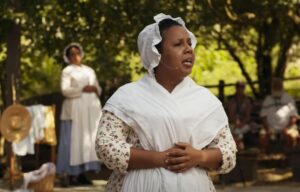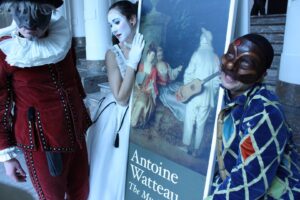

Museum theatre has its origins in the European openair and eco museums that began to emerge over 100 years ago. The field has been shaped not only by the social history and new museology movements of the 20th century, but also by the growth of interdisciplinary, immersive and participatory practice within the contemporary arts. In today’s ‘experience economy’ museum theatre has become a feature of many living history-type events, and is an important means of conveying intangible heritage across the wider cultural tourism and ‘days out’ market.
In line with the broad International Council of Museums definition, the term museum theatre is nowadays also used to describe theatrical techniques and performing arts practice applied within a variety of settings; referring to mediation, communication and interpretation activities in galleries, science centers, historic houses, archaeological sites, botanical gardens, etc.

1st-person interpretation: a communication approach that is delivered ‘in-role’, usually in costume, to critically present a subject position and personal perspective of history or cultural heritage.
Perhaps the best-known and most basic form of museum theatre – upon which most other formats are developed and adapted – is that of 1st-person interpretation. At its best, this kind of person-to-person interpretive practice typically consists of a largely unscripted encounter (perhaps taking the form of a guided tour or talk) between learners/visitors and a thoroughly-researched, carefully presented and costumed persona or character from the past. In some examples of this kind of work, the performer-interpreter may choose to ‘step out of character’ at times; using the 3rd-person to refer to themselves in order to share additional information and context.

Museum theatre in academic research: situated somewhere between museology / museum studies and performance studies, it is both a practice-based methodology and a research focus in its own right.
Much recent research has explored museum theatre’s unique capacity to improve learning enjoyment, overall museum experiences, recall and understanding of interpretive objectives, as well as the way it enables connections to be made between abstract ideas and personal experience. Additionally, museum theatre – a form of applied theatre – has been shown to encourage historical thinking, promote ‘focused looking’ at exhibits, and facilitate interactive engagement through audience participation. Other studies have highlighted museum theatre’s ability to amplify marginalised voices, address challenging content effectively, and leave a lasting impact upon visitors. Most significantly, museum theatre is understood to be a dynamic tool for interpreting intangible aspects of human history, such as behaviours and attitudes of past eras, which can influence contemporary social relationships.


Museum theatre has its origins in the European openair and eco museums that began to emerge over 100 years ago. The field has been shaped not only by the social history and new museology movements of the 20th century, but also by the growth of interdisciplinary, immersive and participatory practice within the contemporary arts. In today’s ‘experience economy’ museum theatre has become a feature of many living history-type events, and is an important means of conveying intangible heritage across the wider cultural tourism and ‘days out’ market.
In line with the broad International Council of Museums definition, the term museum theatre is nowadays also used to describe theatrical techniques and performing arts practice applied within a variety of settings; referring to mediation, communication and interpretation activities in galleries, science centers, historic houses, archaeological sites, botanical gardens, etc.

1st-person interpretation: a communication approach that is delivered ‘in-role’, usually in costume, to critically present a subject position and personal perspective of history or cultural heritage.
Perhaps the best-known and most basic form of museum theatre – upon which most other formats are developed and adapted – is that of 1st-person interpretation. At its best, this kind of person-to-person interpretive practice typically consists of a largely unscripted encounter (perhaps taking the form of a guided tour or talk) between learners/visitors and a thoroughly-researched, carefully presented and costumed persona or character from the past. In some examples of this kind of work, the performer-interpreter may choose to ‘step out of character’ at times; using the 3rd-person to refer to themselves in order to share additional information and context.
Museum theatre in academic research: situated somewhere between museology / museum studies and performance studies, it is both a practice-based methodology and a research focus in its own right.
Much recent research has explored museum theatre’s unique capacity to improve learning enjoyment, overall museum experiences, recall and understanding of interpretive objectives, as well as the way it enables connections to be made between abstract ideas and personal experience. Additionally, museum theatre – a form of applied theatre – has been shown to encourage historical thinking, promote ‘focused looking’ at exhibits, and facilitate interactive engagement through audience participation. Other studies have highlighted museum theatre’s ability to amplify marginalised voices, address challenging content effectively, and leave a lasting impact upon visitors. Most significantly, museum theatre is understood to be a dynamic tool for interpreting intangible aspects of human history, such as behaviours and attitudes of past eras, which can influence contemporary social relationships.
Interpret Europe: itself a member of the Global Alliance for Heritage Interpretation, Interpret Europe represents more than 800 members from more than 48 countries and acts as a European platform for cooperation and exchange. It organises networking, training and advocacy actions in service of the interpretation community at large – furthering research and championing best practice. As museum theatre is a form of person-led/’live’ interpretation, it sits firmly within this community of practice and adheres to the same high standards.
IMTAL Europe: The European branch of the International Museum Theatre Alliance supports the organisation’s overall mission of promoting the use of theatre and theatrical techniques to cultivate emotional connections, provoke action, and add public value to the museum experience. Established in 1990, IMTAL’s conferences and networking events have sought to highlight best practice and emerging trends in museum theatre, bringing together veteran practitioners, emerging professionals, academics and students from around the world to support and inspire each other.
EXARC supports research and collaboration opportunities across four key areas – ancient technology, experimental archaeology, interpretation and museum practice – with a special focus on educational and presentational tools and demonstrations of cultural heritage. Museum theatre has its origins in the European openair and eco museums that began to emerge over 100 years ago, so the field of experimental archaeology, as both a practical research methodology and as a means of public engagement / science communication is, in many respects, its birthplace.
Dance & Museums Network: This informal network of dance and museum practitioners is connected to the UK’s Imagination Museum initiative. Along with the European Union co-funded Dancing Museums actions (2015-17 and 2018-21), efforts like these represent a growing area of enquiry within the wider museum theatre field, that seeks to explore the specific properties and potential of dance and movement within heritage interpretation – exciting stuff!!
The International Bibliographic Database of Living History hosted by the University Library of the Catholic University of Linz this database provides easy access to a broad selection of bibliographical references concerning historic interpretation, museum theatre, storytelling, experimental archaeology, and reenactment. Launched in 2012, the database is continually updated and warmly welcomes notifications about new publications that can be added (see the site for details)
